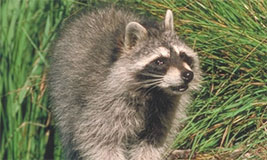|
Mammal.
Mostly solitary, raccoons forage at night and sleep in their dens
during the day. Their excellent night vision and hearing make them
especially alert. Using sensitive, five-fingered forepaws, raccoons
easily manipulate and open things. They are strong, though reluctant,
swimmers and good climbers not afraid of dropping from a height of
12 meters (40 ft). Adults measure 46-66 cm (18-26 in) in length,
plus a striped tail that's 23-35 cm (9-14 in) long. Females are usually
smaller than males. When first born both their ears and eyes are
closed, taking 18 to 24 days to open. After 4 to 6 weeks they can
walk. |
| Scientific
Name |
Lifespan |
| Procyon lotor |
5 to 6 years in the wild |
| Diet |
| Omnivore. They eat almost anything that's edible
including fruit, acorns, nuts, corn and other grains, crayfish
and other water animals, frogs, birds and bird eggs, small
mammals, and even garbage. |
| Predators and
Threats |
| Many raccoons are hit by cars. Predators include
foxes, owls, bobcats and coyotes. |
| Habitat |
| They prefer wetland areas near streams, marshes,
lakes, swamps, and rivers. Highly adaptable, they can also
be found in urban and suburban areas. Raccoons range from
Canada into northern South America. |





